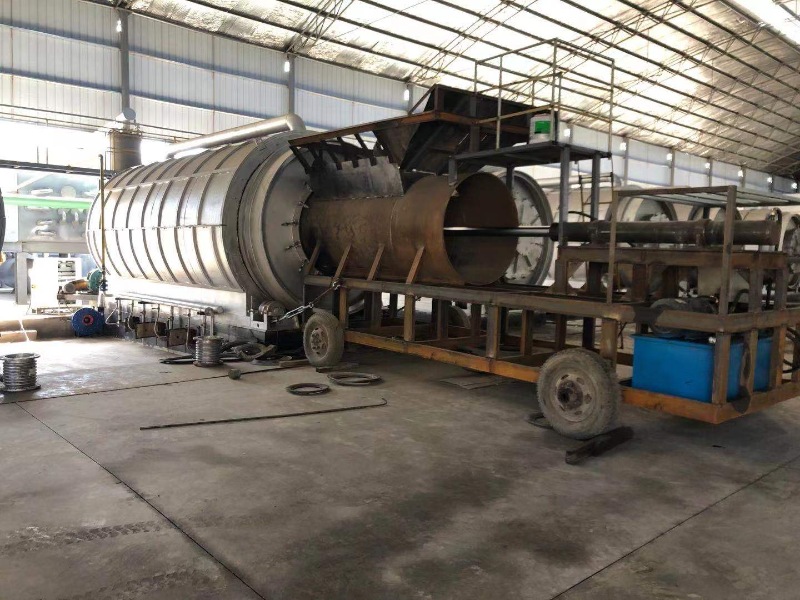A pyrolysis plant is an innovative solution to the growing issue of waste management. This technology enables the conversion of various types of waste materials into valuable products like fuel, carbon black, and industrial chemicals. With the increasing global demand for sustainable and eco-friendly alternatives, pyrolysis plants are playing an essential role in reducing waste, conserving natural resources, and producing energy. This article will delve into the working mechanism, benefits, and applications of pyrolysis plants, with a particular focus on the Waste Rubber Pyrolysis Production Line and the Pyrolysis Machine.
A pyrolysis plant is a system designed to thermally decompose organic materials in an oxygen-free environment. This process, known as pyrolysis, breaks down waste into useful by-products such as fuel oil, carbon black, and syngas. The process takes place at high temperatures, typically between 350°C and 700°C, and the type of waste being processed will dictate the end products produced.
The pyrolysis process has become a viable solution for managing a wide variety of waste types, including plastic, rubber, tires, biomass, and municipal solid waste. The resulting by-products can be utilized for energy generation, fuel for industrial use, and as raw materials for other industries. This not only reduces the burden of waste on landfills but also offers a sustainable way to recycle and repurpose materials that would otherwise have little value.
A typical pyrolysis plant consists of several essential components, including:
Reactor: The central unit where the pyrolysis process occurs. Waste materials are loaded into the reactor and heated to the desired temperature in an oxygen-free environment.
Condenser: This component cools down the gas produced during pyrolysis, converting it into liquid fuel oil.
Carbonization System: Converts solid materials like rubber and plastic into carbon black.
Gas Treatment Unit: The pyrolysis gas is treated and purified for use as a fuel in the plant or for other industrial applications.
Cooling System: Helps cool down the solid residue (carbon black) and other products once the process is complete.
Control Panel: Allows for monitoring and regulating the entire process, ensuring safety and optimal efficiency.

One of the most popular applications of pyrolysis plants is the Waste Rubber Pyrolysis Production Line. The waste rubber, particularly from discarded tires, is a growing environmental concern due to its volume and difficulty in disposal. A Waste Rubber Pyrolysis Production Line can effectively break down these materials and convert them into valuable products such as fuel oil, carbon black, and steel wire. These products have a variety of industrial uses, making them highly profitable and eco-friendly.
Moreover, pyrolysis technology can also be applied to plastic waste, where it can turn non-recyclable plastics into usable oils and gases. This not only reduces the plastic pollution problem but also helps in generating useful by-products that can be used as alternative fuels.
In addition to waste rubber and plastic, pyrolysis plants are also widely used to process organic materials like agricultural waste, including crop residues and forestry by-products, which can be converted into biofuels, biochar, and other energy products. These materials serve as renewable resources that can replace fossil fuels and help meet global energy needs.
Waste Reduction: Pyrolysis plants help significantly reduce waste volume, diverting waste from landfills and minimizing the environmental impact of waste disposal.
Energy Production: The by-products produced, including oil and gas, can be used as alternative fuels, contributing to energy generation.
Eco-Friendly: Pyrolysis is a clean process, producing no harmful emissions when managed correctly. The process not only recycles waste but also produces eco-friendly products.
Economic Value: The valuable by-products, such as fuel oil and carbon black, can be sold for use in other industries, generating a revenue stream for businesses operating the pyrolysis plants.
Sustainability: The technology supports a circular economy by converting waste materials into useful products, which helps reduce the need for virgin resources.
As the world moves toward more sustainable and circular economy models, the demand for pyrolysis technology is expected to grow. The ability of pyrolysis plants to convert waste into high-value products makes them an essential part of the future of waste management and energy production.
Investing in a Pyrolysis Machine that is efficient, reliable, and eco-friendly can lead to significant environmental and financial benefits. The technology is continuously evolving, with improvements in efficiency, energy recovery, and emissions control, paving the way for even more widespread adoption in the future.
Pyrolysis plants are revolutionizing waste management by converting waste materials into valuable products that can be reused and repurposed in various industries. Whether it is the Waste Rubber Pyrolysis Production Line for tire recycling or the Pyrolysis Machine used for processing plastics and biomass, the versatility of pyrolysis technology offers numerous benefits for the environment and the economy. By investing in modern pyrolysis solutions, businesses and governments can help tackle waste problems while contributing to sustainable energy production.
To explore further how a pyrolysis plant works and to discover specific applications, visit this link for a 15 TPD pyrolysis plant.
Previous: Why Choose a Solar Rechargeable Fan for Your Cooling Needs?
Next: Solar Table Fan: The Perfect Blend of Sustainability and Convenience
Copyright:@2020-2021
Comments Please sign in or sign up to post.
0
0 of 500 characters used